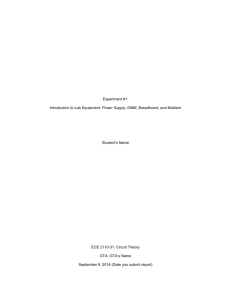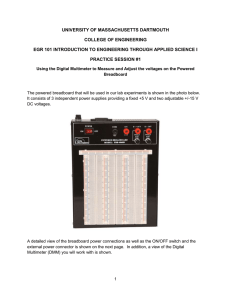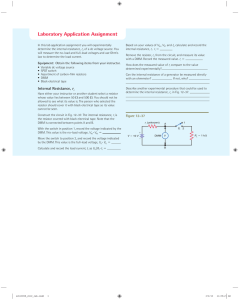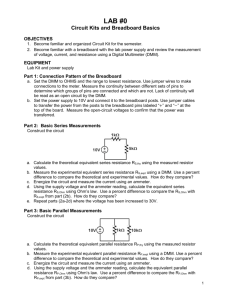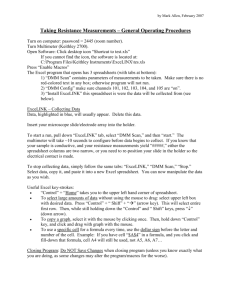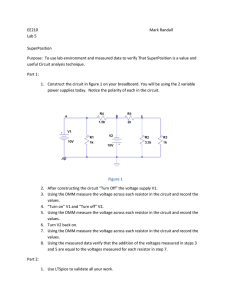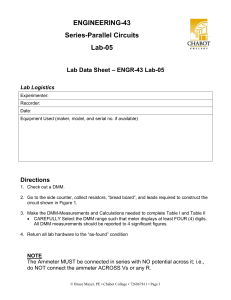I-1. The Breadboard, the Digital Multimeter and Resistance
advertisement
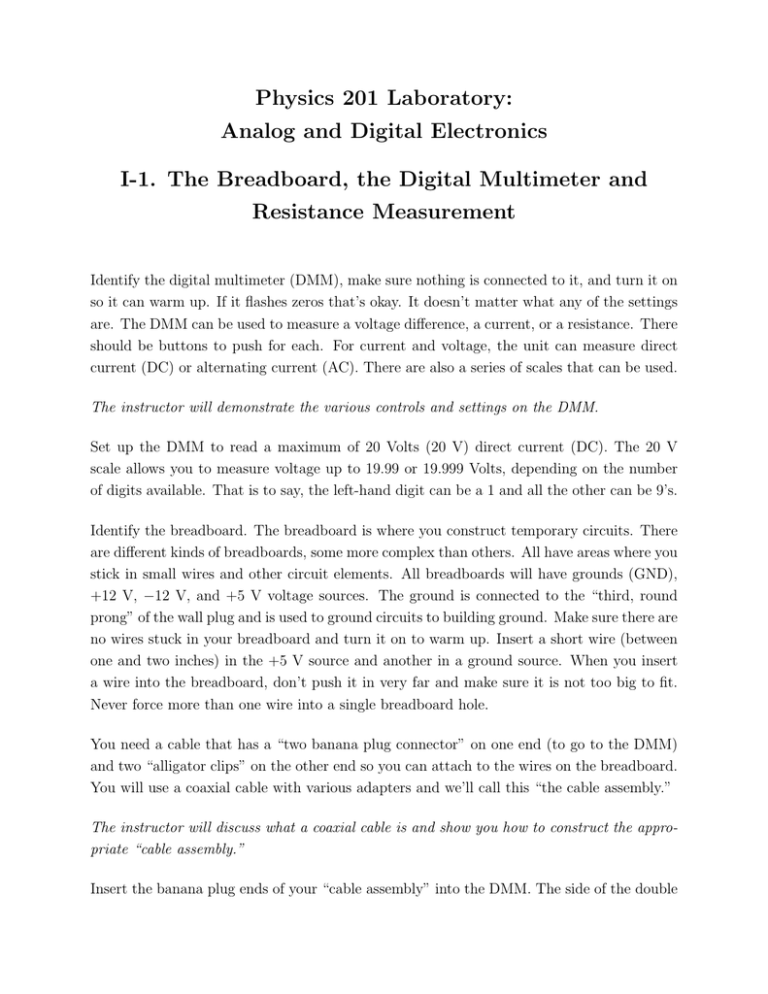
Physics 201 Laboratory: Analog and Digital Electronics I-1. The Breadboard, the Digital Multimeter and Resistance Measurement Identify the digital multimeter (DMM), make sure nothing is connected to it, and turn it on so it can warm up. If it flashes zeros that’s okay. It doesn’t matter what any of the settings are. The DMM can be used to measure a voltage difference, a current, or a resistance. There should be buttons to push for each. For current and voltage, the unit can measure direct current (DC) or alternating current (AC). There are also a series of scales that can be used. The instructor will demonstrate the various controls and settings on the DMM. Set up the DMM to read a maximum of 20 Volts (20 V) direct current (DC). The 20 V scale allows you to measure voltage up to 19.99 or 19.999 Volts, depending on the number of digits available. That is to say, the left-hand digit can be a 1 and all the other can be 9’s. Identify the breadboard. The breadboard is where you construct temporary circuits. There are different kinds of breadboards, some more complex than others. All have areas where you stick in small wires and other circuit elements. All breadboards will have grounds (GND), +12 V, −12 V, and +5 V voltage sources. The ground is connected to the “third, round prong” of the wall plug and is used to ground circuits to building ground. Make sure there are no wires stuck in your breadboard and turn it on to warm up. Insert a short wire (between one and two inches) in the +5 V source and another in a ground source. When you insert a wire into the breadboard, don’t push it in very far and make sure it is not too big to fit. Never force more than one wire into a single breadboard hole. You need a cable that has a “two banana plug connector” on one end (to go to the DMM) and two “alligator clips” on the other end so you can attach to the wires on the breadboard. You will use a coaxial cable with various adapters and we’ll call this “the cable assembly.” The instructor will discuss what a coaxial cable is and show you how to construct the appropriate “cable assembly.” Insert the banana plug ends of your “cable assembly” into the DMM. The side of the double I-1. The Breadboard, the Digital Multimeter and Resistance Measurement p. 2 banana plug with the bump is the ground side and should go to the LO end of the DMM. Attach both clips on the other end of your “cable assembly” to a wire coming out of the ground (GND) on the breadboard. After the breadboard and the DMM have been on for about ten minutes, the DMM should read near zero, to within a few of the least significant (rightmost) units on the display. If the reading is far from zero, the DMM should be zeroed. When a reading is taken using the DMM, it contains an inherent uncertainty which is a property of all digital measuring devices. A reading of 10.000 V, on the 20 V scale, may be between 9.9996 V and 10.0004 V, since any number in this range will be rounded to 10.000 if only three digits after the decimal are significant. The actual number of decimal places will depend on the particular DMM and on the scale used. To be safe, due to uncertainties in the instrument itself, you should record the uncertainty in a DMM reading as ±2 of the right most digit. In this case, then, the measured value is 10.000 V ± 0.002 V. On another scale, say a 2 kV scale the same voltage may read 0.010 (since 10 V is 0.01 kV), so the recorded value is now 0.010 ± 0.002 kV or 10 ± 2 V. Note the change in significant digits and percentage uncertainty. The black alligator clip always goes to ground and should be left there all the time while using the DMM to measure voltages. As such, the LO end of the DMM, corresponding to the side of the banana plug with the bump, is connected to ground. It is the red alligator clip that goes to places whose voltage you want to measure. Note that the LO end of the DMM is not grounded inside the DMM. One says that the two inputs of the DMM are “floating.” However, you have now grounded the LO end of the DMM (by connecting it to the breadboard ground) so it is no longer floating. Connect the HI end of the DMM input (via the red alligator clip) to the +12 V DC, then the −12 V DC, and then the +5 V DC outputs of the breadboard. Record the readings. What is the percent difference between the recorded voltages and the nominal (i.e, that which is stated on the breadboard) voltages of +12, −12 and +5 V? Remove the two leads from the breadboard. Always remove the high voltage side first (that which is not ground: +12 V, −12 V, or +5 V), and then remove the ground lead. This doesn’t really matter with the low voltages with which we deal in this course, but it is a safe practice to develop. With the alligator clips going nowhere, set the DMM to read HI Ω (ohms). (On Keithley 179 and 179A DMMs units, also depress the 20 MΩ button.) Notice that the unit flashes zeroes. This indicates that the reading is off-scale. This condition will not harm the DMM when it is in ohmmeter mode. (Flashing zeroes in either voltage or current modes indicates that the reading is off scale. This can damage the unit.) In this instance, the ohmmeter flashes zero I-1. The Breadboard, the Digital Multimeter and Resistance Measurement p. 3 because it is reading infinite resistance (i.e., an open circuit): the two leads of the DMM are not connected either to each other or through a circuit element (such as a resistor). The ohmmeter produces its own tiny current, records the voltage difference between its leads, and uses Ohm’s Law to calculate the resistance between the leads. In light of this, the DMM, while in ohmmeter mode, does not require an external source of current, so a resistor may be connected directly between the DMM leads. Do not use the DMM in ohmmeter mode while the leads are connected to a live circuit (i.e., one in which current is flowing). This may give erroneous readings and may even damage the DMM. With your two breadboard wires, discover which holes on the breadboard are internally connected to each other. You can do this by placing wires into various holes and attaching the alligator clips to these wires. When you are between two holes that are connected underneath, inside the breadboard, the ohmmeter will read zero (ohms); when you are between two holes which are not connected, the ohmmeter will display flashing zeros (infinite resistance). After you have probed the breadboard for a while, you will notice that some horizontal or vertical rows of holes are internally connected (no resistance between them), while other vertical or horizontal columns of holes are not connected. This feature allows you to connect wires and circuit elements at a point of common potential. Make a careful diagram of the breadboard noting what is connected to what. That’s all for the breadboard for now. Remove all the wires and clean up the work area. Obtain three resistors: 100 Ω, 1 kΩ, and 10 kΩ. The resistors are kept in separate drawers at the front of the lab; each drawer has many sections of resistors of different resistances. Always check the color code on a resistor you intend to use to ensure that it was not improperly placed in the drawer. Resistors come in several sizes and shapes, and their values are denoted by a series of several colored bands. The first three bands mark the resistance in ohms, and the fourth, if it is present, marks the tolerance. The tolerance bands are only gold or silver; gold means 5%, silver 10%, and no band means 20%. I-1. The Breadboard, the Digital Multimeter and Resistance Measurement p. 4 1 2 M T Figure 1: Resistor bands. COLOR Black Brown Red Orange Yellow Green Blue Violet Gray White Silver Gold 1st DIGIT 0 1 2 3 4 5 6 7 8 9 2nd DIGIT 0 1 2 3 4 5 6 7 8 9 MULTIPLY BY 1 101 = 10 102 = 100 103 104 105 106 107 108 109 0.1 0.05 Table 1: Interpretation of color bands. The color code for the first three bands is displayed above and a color chart may be available. Example: a 10 kΩ resistor will have as its first three bands brown (1), black (0), and orange (×1000), in this order, for 10 × 1000 Ω = 10, 000 Ω, or 10 kΩ. If the fourth band were gold (5% tolerance), the resistor would be expected to register between 9.5 and 10.5 kΩ on the ohmmeter, the 0.5 kΩ tolerance being 5% of the nominal 10 kΩ resistance. Note that after the resistor is measured with the ohmmeter, its resistance is known to the precision of the digital readout, and the tolerance is no longer applicable. Thus, if this resistor registered 10.062 on the 20 kΩ scale, it would be within tolerance (10.062 kΩ is less than 5% away from 10 kΩ), and the tolerance is now meaningless. The instructor will discuss the concepts of uncertainty and tolerance and review how to interpret the resistor code. I-1. The Breadboard, the Digital Multimeter and Resistance Measurement p. 5 Measure the three resistors with the DMM set in ohmmeter mode by connecting the DMM leads to each end of a resistor. Experiment with the 1 kΩ 10-turn helipot (variable resistor). Set it up so that the resistance measured by the DMM in ohmmeter mode is zero and maximum (∼ 1 kΩ) when the dial is set at its zero and its maximum, respectively. This may require testing each combination of two leads (of the three) to see which gives the proper behavior. Make a schematic of this helipot, noting the color of the wires.
